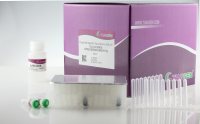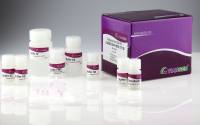图谱用基因组DNA的提取
互联网
1275
|
|
- grow plants in trays of 96 and leave two spots open (for the PCR controls)
- harvest 1 to 2 young and green leaves (1cm2/plant, at rosette stage if possible). Use 96 well plates (1 or 2 ml, E&K, polypropylene, round bottom). Process all and freeze in liquid nitrogen
- grind tissue for 30 sec per row with a "12-finger comb" (specially built to fit into the wells) while still frozen
- add 400 ml of preheated (65°C) extraction buffer, mix and let float in waterbath at 65°C for 10 to 60 min
- spin down 15 to 20 min (5000 rpm) and transfer 300 ml of the supernatant to a new 96 well plate (E&K, 1ml, polypropylene) containing 300 ml isopropanol/well
- mix and wait 5 min at RT (can wait much longer)
- spin 30 to 45 min (5000 rpm). Pour off supernatant
- wash pellets with 70% EtOH and air dry (e.g., ovn)
- resuspend pellets in 50-100 ml 1x TE
- use 1-3 ml per PCR rxn
Remarks:Extraction buffer: 200 mM Tris-HCl pH 7.5, 250 mM NaCl, 25 mM EDTA, 0.5% SDS
Extraction Buffer 1 M Tris-HCl pH 7.510.00 ml5 M NaCl2.50 ml0.5 M EDTA2.50 ml20% SDS1.25 mlH2O33.75 mlTotal50.00 ml
This protocol is quick, reliable and the DNA obtained can be used for PCR-based mapping using SSLP and CAPS markers. It is based on the protocol by Edwards et.al., 1991, NAR 19: 1349. It was adapted for large-scale applications by the Somerville lab.








